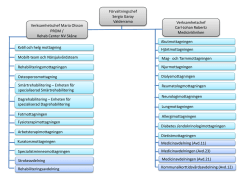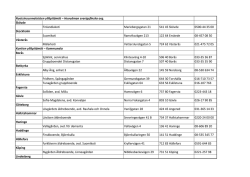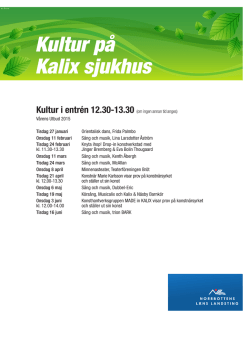
Forskning (PRINT).pptx
Evolution och fylogeni Introduktion till forskningen… Ernst Haeckel, 1866… Klassifikation på basis av släktskap Generelle Morphologie der Organismen morfologi = formlära, vilka former något kan ta Första publicerade släktträdet över alla organismer… Anders Backlund Anders Backlund Avd. f. Farmakognosi Inst. f. Läkemedelskemi 2015.10.01 Anders Backlund Avd. f. Farmakognosi Inst. f. Läkemedelskemi ”Chaos is creation A swirling mass of atoms and ideas Natural selection the sculptor of all life” ”Cult of Chaos” av Arch Enemy Fylogenier Synopsis vs, fylogeni Willie Hennig, 1950, 1960… Dipsacales Klassifikation på basis av släktskap Adoxaceae Caprifoliaceae Collumelliaceae Diervillaceae Dipsacaceae • Linnaeaceae Morinaceae Valerianaceae • Identifierandet av monofyletiska grupper ”en förfader och all dess avkomma” Anders Backlund Anders Backlund Avd. f. Farmakognosi Inst. f. Läkemedelskemi Avd. f. Farmakognosi Inst. f. Läkemedelskemi Fylogenier Fylogenier Välj tre studieobjekt… SAX Disanthus cercidifolius SAX Hamamelis Anders Backlund Avd. f. Farmakognosi Inst. f. Läkemedelskemi CAR Asteropeia micraster CAR Phytolacca SAX Heuchera CAR Portulaca SAX Saxifraga SAX Peltoboykinia tellimoides CAR Nepenthes CAR Pereskia CAR Triphyophyllum peltatum CAR Tamarix SAN Heisteria SAX Sullivantia CAR Drosera SAX Paeonia AST Campanula SAX Soyauxia SAN Bakerella CAR Plumbago API Delarbrea michieana SAX Haloragis CRO Staphylea AST Codonopsis CAR Polygonum AST Corokia cotoneaster SAX Tetracarpaea tasmanica SAN Olax GER Viviania marifolia AST Menyanthes SAN Cansjera SAX Crassula AST Helianthus annuus trifoliata CAR Celosia Opilia AST Barnadesia SAX Dudleya viscida CAR Stellaria media SANSAN Thesium SAX Sedum CAR Mirabilis jalapa SAN AST Tragopogon Thesium alpinum CRO Crossosoma PRO Grevillea API Melanophylla alnifolia SAX Itea API Griselinia lucida TAP Perrottetia longistylis GER Geranium SAX Ribes GER Greyia radlkoferi SAB Sabia API Apium graveolens RAN Caulophyllum thalictroides SAN Schoepfia schreberi SAP Cupaniopsis anacardioides ERI Anagallis API Pittosporum SAP Swietenia macrophylla DIP Symphoricarpos SAP Aesculus SAN Socratina kerauderiana DIP Valeriana officinalis ERI Pentaphylax euryoides ERI Polemonium DIP Abelia PRO Lambertia inermis TAP Tapiscia sinensis SAN Jodina rhombifolia RAN Xanthorhiza simplicissima COR Philadelphus DIP Dipsacus Barringtonia TAP Dipentodon sinicus DIP ERI Impatiens ERI Gunnera aralioides Scabiosa TROGUN Trochodendron ERI Manilkara zapota BRA Tropaeolum TAP Perrottetia ovata ERI Halesia ERI Sarracenia SAN Comandra SAN Pyrularia pubera umbellata OXA BaueraERI Styrax MLV Ochroma pyramidale ERI Cyrilla racemifloraSAN Buckleya distichophylla ERI Vaccinium BRA Carica papaya SAN Scleropyrum SAB Meliosma veitchiorum CEL Hippocratea barbata SAN Acanthosyris asipapotepentandrum OXA Elaeocarpus GAR Icacina CEL Stackhousia monogyna BUX Didymeles perrieri BRA Cleome hassleriana TRO Tetracentron sinense SAN Cervantesia tomentosa OXA Davidsonia pruriens CUC Corynocarpus laevigatus ERI Galax urceolata ZYG Krameria LAM Byblis SAN Acanthosyris falcata ZYG Larrea tridentata MLV Bombax BUX Buxus sempervirens CUC Datisca cannabina CEL Lepuropetalon MAL Hypericum perforatum spathulatum LAM Myoporum BUX Pachysandra GAR Aucuba japonica SANalbum Santalum album CUC Datisca glomerata CEL Parnassia palustris SAN Viscum GAR Garrya elliptica SAN Eubrachion ambiguum RAN Dicentra FAG Fagus grandifolia GUN Myrothamnus BRA Capparis RAN Euptelea polyandra FAG Chrysolepis sempervirens GAR Pyrenacantha SAN Arceuthobium verticilliflorum SAX Cercidiphyllum CEL Celastrus orbiculatus RAN Akebiajaponicum quinata LAM Olea europaea CEL Euonymus alatus RAN Glaucidium palmatum SAN Dendrophthora clavata SAX Liquidambar FAB Albizia julibrissin CUC Begonia RAN Podophyllum peltatum GEN Exacum affine LAM Verbascum thapsus MAL Euphorbia MAL Populus RAN Hydrastis canadensis SAN Osyris LAM Plantago FAB SecuridacaFAG diversifolia MAL Reinwardtia indica Morella BOR Ehretia MAL Casearia LAM Verbena PRO Nelumbo BOR Borago officinalis PRO Platanus occidentalis ROS Ceanothus MAL Lophopyxis maingayi Quercus GEN Mitchella repens ROS Elaeagnus MAL FAG Bhesa paniculata SAX Daphniphyllum COR Alangium PRO Macadamia sp SAN Korthalsella MAL Bhesa robusta MAL Chrysobalanus icacoGEN Gelsemium sempervirens FAB Medicago FAB Polygala SAN Phoradendron serotinum SOL Ipomoea GEN Nerium oleander BER Aextoxicon punctatum SOL Hydrolea ovata ROS Humulus lupulus BER Berberidopsis corallina ROS Photinia SOL Nolana SOL Montinia caryophyllacea OXA Averrhoa carambola ROS Spiraea SOL Petunia COR Cornus SOL Schizanthus pinnatus COR Curtisia dentata PRO Protea AQU Gonocaryum litorale ROS Zelkova COR Grubbia tomentosa AQU Cardiopteris quinqueloba COR Nyssa ROS Morus AQU Phyllonoma AQU Irvingbaileya sp COR Petalonyx nitidus ROS Celtis COR Hydrangea macrophylla AQU Ilex OXA Oxalis Välj tre studieobjekt från ’trädet’… Anders Backlund Avd. f. Farmakognosi Inst. f. Läkemedelskemi AQU Helwingia japonica AST Roussea simplex Liv på Jorden… RAN Dicentra RAN Euptelea polyandra RAN Akebia quinata RAN Caulophyllum thalictroides RAN Podophyllum peltatum RAN Glaucidium palmatum RAN Hydrastis canadensis RAN Xanthorhiza simplicissima PRO Nelumbo PRO Platanus occidentalis PRO Protea PRO Macadamia PRO Grevillea PRO Lambertia inermis SAB Meliosma veitchiorum SAB Sabia TRO Tetracentron sinense TRO Trochodendron aralioides BUX Didymeles perrieri BUX Buxus sempervirens BUX Pachysandra GUN Gunnera GUN Myrothamnus SAX Cercidiphyllum japonicum SAX Daphniphyllum sp SAX Liquidambar SAX Disanthus cercidifolius SAX Hamamelis SAX Itea SAX Ribes SAX Heuchera SAX Peltoboykinia tellimoides SAX Saxifraga SAX Sullivantia SAX Paeonia SAX Soyauxia SAX Haloragis SAX Tetracarpaea tasmanica SAX Crassula SAX Dudleya viscida SAX Sedum CRO Crossosoma CRO Staphylea GER Geranium GER Greyia radlkoferi GER Viviania marifolia SAP Swietenia macrophylla SAP Aesculus SAP Cupaniopsis anacardioides TAP Tapiscia sinensis TAP Dipentodon sinicus TAP Perrottetia longistylis TAP Perrottetia ovata MLV Bombax MLV Ochroma pyramidale BRA Tropaeolum BRA Carica papaya BRA Capparis BRA Cleome hassleriana CUC Corynocarpus laevigatus CUC Begonia CUC Datisca cannabina CUC Datisca glomerata FAG Morella FAG Fagus grandifolia FAG Chrysolepis sempervirens FAG Quercus FAB Albizia julibrissin FAB Medicago FAB Polygala FAB Securidaca diversifolia ROS Photinia ROS Spiraea ROS Ceanothus ROS Elaeagnus ROS Zelkova ROS Morus ROS Celtis ROS Humulus lupulus OXA Averrhoa carambola OXA Oxalis OXA Elaeocarpus OXA Bauera OXA Davidsonia pruriens ZYG Krameria ZYG Larrea tridentata CEL Lepuropetalon spathulatum CEL Parnassia palustris CEL Stackhousia monogyna CEL Hippocratea barbata CEL Celastrus orbiculatus CEL Euonymus alatus MAL Chrysobalanus icaco MAL Euphorbia MAL Hypericum perforatum MAL Reinwardtia indica MAL Casearia MAL Populus MAL Lophopyxis maingayi MAL Bhesa paniculata MAL Bhesa robusta Eukaryoter Fungi Animalia Phaeophyta Chrysophyta EUKARYOTA Xanthophyta Oomycota ... Dinoflagellata Ciliata Apicomplexa Rhodophyta Myxomycota Chlorophyta Cyanophyta Entamoeba Amoeba Kinetoplastida α-proteo Euglenophyta Trichomonads Microsporidia EUBACTERIA Diplomonads Anders Backlund Anders Backlund Avd. f. Farmakognosi Inst. f. Läkemedelskemi Avd. f. Farmakognosi Inst. f. Läkemedelskemi ARCHAEBACTERIA Omritat och justerat efter M. L. Sogin et al. Current Opinions in Genetics and Development 1: 457 (1991) Från Baldauf et al., The Deep Roots of Eukaryotes Science 300: 1703-1706 (2003). CAR Nepenthes CAR Triphyophyllum peltatum CAR Drosera CAR Tamarix CAR Plumbago CAR Polygonum CAR Asteropeia micraster CAR Celosia CAR Stellaria media CAR Mirabilis jalapa CAR Phytolacca CAR Pereskia CAR Portulaca SAN Heisteria SAN Schoepfia schreberi SAN Bakerella SAN Socratina kerauderiana SAN Olax SAN Cansjera SAN Opilia SAN Thesium SAN Thesium alpinum SAN Comandra umbellata SAN Buckleya distichophylla SAN Pyrularia pubera SAN Scleropyrum pentandrum SAN Jodina rhombifolia SAN Cervantesia tomentosa SAN Acanthosyris asipapote SAN Acanthosyris falcata SAN Osyris SAN Santalum album SAN Eubrachion ambiguum SAN Viscum album SAN Arceuthobium verticilliflorum SAN Korthalsella SAN Dendrophthora clavata SAN Phoradendron serotinum BER Aextoxicon punctatum BER Berberidopsis corallina COR Alangium COR Cornus COR Curtisia dentata COR Grubbia tomentosa COR Nyssa COR Petalonyx nitidus COR Hydrangea macrophylla COR Philadelphus ERI Barringtonia ERI Manilkara zapota ERI Pentaphylax euryoides ERI Sarracenia ERI Cyrilla racemiflora ERI Vaccinium ERI Polemonium ERI Anagallis ERI Impatiens ERI Galax urceolata ERI Halesia ERI Styrax GAR Aucuba japonica GAR Garrya elliptica GAR Icacina GAR Pyrenacantha LAM Olea europaea LAM Byblis LAM Verbascum thapsus LAM Myoporum LAM Plantago LAM Verbena BOR Borago officinalis BOR Ehretia GEN Mitchella repens GEN Gelsemium sempervirens GEN Exacum affine GEN Nerium oleander SOL Hydrolea ovata SOL Montinia caryophyllacea SOL Ipomoea SOL Schizanthus pinnatus SOL Nolana SOL Petunia AQU Irvingbaileya sp AQU Gonocaryum litorale AQU Cardiopteris quinqueloba AQU Phyllonoma AQU Helwingia japonica AQU Ilex AST Roussea simplex AST Campanula AST Codonopsis AST Corokia cotoneaster AST Menyanthes trifoliata AST Barnadesia AST Helianthus annuus AST Tragopogon API Melanophylla alnifolia API Griselinia lucida API Delarbrea michieana API Apium graveolens API Pittosporum DIP Symphoricarpos DIP Valeriana officinalis DIP Abelia DIP Dipsacus DIP Scabiosa 1 2 3 4 APG & APG II (III) Växtsystematik vid Katholiek Universitet Leuven, Belgien… An ordinal classification of flowering plants. The Angiosperm Phylogeny Group (29 författare) …eller bioinformatik vid Trinity College Dublin, Ireland. Annals of the Missouri Botanical Garden 1998, 85, pp. 531-553. ––––––––––––––––––––––––––––––––––––– An update of the Angiosperm Phylogeny Group classification for the orders and families of flowering plants: APG II 1997 Anders Backlund Anders Backlund Avd. f. Farmakognosi Inst. f. Läkemedelskemi Avd. f. Farmakognosi Inst. f. Läkemedelskemi The Angiosperm Phylogeny Group (27 författare) Botanical Journal of the Linnean Society 2003, 141, pp. 399-436. Amborellaceae Nymphaeaceae Austrobaileyales Chloranthaceae Canellales Piperales Laurales Magnoliales Acorales Alismatales Asparagales Dioscoreales Liliales Pandanales Arecales Poales Commelinales Zingiberales Ceratophyllales Ranunculales Proteales Gunnerales Caryophyllales Santalales Saxifragales Crossostomatales Geraniales Myrtales Celastrales Malphigiales Oxalidales Fabales Rosales Cucurbitales Fagales Brassicales Malvales Sapindales Cornales Ericales Garryales Gentianales Lamiales Solanales Aquifoliales Asterales Apiales Dipsacales Foton: Anders Backlund MARISCO-projektet Fotosyntetiserande organismer… Improving arable production systems by expressing marine algal RuBisCO in crop plants – EU project QLK3-2002-01945 Co-ordinator: Prof. Inger Andersson, Dept. of Molecular Biology, Swedish University of Agricultural Sciences / Stanford University Anders Backlund Anders Backlund Avd. f. Farmakognosi Inst. f. Läkemedelskemi Avd. f. Farmakognosi Inst. f. Läkemedelskemi RuBisCO L2 L8 L10 Anders Backlund Anders Backlund Avd. f. Farmakognosi Inst. f. Läkemedelskemi Avd. f. Farmakognosi Inst. f. Läkemedelskemi L8S8 First crystal structure of Rubisco from a Green Algae, Chlamydomonas reinhardtii. Taylor, T., Backlund, A., Björhall, K., Spreitzert, R.J., Andersson, I. J. Biological Chemistry 276: 48159-48164 (2001). Strese et al. BMC Evolutionary Biology 2014, 14:119 http://www.biomedcentral.com/1471-2148/14/119 RESEARCH ARTICLE Open Access A recently transferred cluster of bacterial genes in Trichomonas vaginalis - lateral gene transfer and the fate of acquired genes Åke Strese1, Anders Backlund1 and Cecilia Alsmark1,2* Abstract Background: Lateral Gene Transfer (LGT) has recently gained recognition as an important contributor to some eukaryote proteomes, but the mechanisms of acquisition and fixation in eukaryotic genomes are still uncertain. A previously defined norm for LGTs in microbial eukaryotes states that the majority are genes involved in metabolism, the LGTs are typically localized one by one, surrounded by vertically inherited genes on the chromosome, and phylogenetics shows that a broad collection of bacterial lineages have contributed to the transferome. Results: A unique 34 kbp long fragment with 27 clustered genes (TvLF) of prokaryote origin was identified in the sequenced genome of the protozoan parasite Trichomonas vaginalis. Using a PCR based approach we confirmed the presence of the orthologous fragment in four additional T. vaginalis strains. Detailed sequence analyses unambiguously suggest that TvLF is the result of one single, recent LGT event. The proposed donor is a close relative to the firmicute bacterium Peptoniphilus harei. High nucleotide sequence similarity between T. vaginalis strains, as well as to P. harei, and the absence of homologs in other Trichomonas species, suggests that the transfer event took place after the radiation of the genus Trichomonas. Some genes have undergone pseudogenization and degradation, indicating that they may not be retained in the future. Functional annotations reveal that genes involved in informational processes are particularly prone to degradation. Conclusions: We conclude that, although the majority of eukaryote LGTs are single gene occurrences, they may be acquired in clusters of several genes that are subsequently cleansed of evolutionarily less advantageous genes. Keywords: Lateral gene transfer (LGT), Trichomonas, Peptoniphilus, Phylogeny Anders Backlund Anders Backlund Avd. f. Farmakognosi Inst. f. Läkemedelskemi Avd. f. Farmakognosi Inst. f. Läkemedelskemi Structure and function of Rubisco Andersson, I., Backlund, A. Plant Physiology and Biochemistry 46: 275-291 (2008). Background The protozoan parasite Trichomonas vaginalis is a human pathogen that causes the most common, non-viral, sexually transmitted disease in the world, infecting 248 million people yearly according to WHO estimates [1]. Men are often asymptomatic carriers of the parasite, while symptoms in women range from malodorous vaginal discharge, inflammation and swelling of the urogenital tract to increased risk for cervical cancer, adverse pregnancy outcomes and an increased susceptibility to HIV-1 infection [2-4]. Treatment today is limited to two nitroimidazole derivatives, tinidazole and metronidazole, although failure * Correspondence: cecilia.alsmark@fkog.uu.se 1 Division of Pharmacognosy, Department of Medicinal Chemistry, Uppsala University, Uppsala, Sweden 2 Department of Virology, Immunobiology and Parasitology, National Veterinary Institute, Uppsala, Sweden of treatment due to resistance has been reported [5]. A draft genome sequence of T. vaginalis G3 was accomplished in 2007 [6], revealing an unusually large genome of more than 160 Mbp, encoding up to 60,000 genes in addition to numerous and diverse repeated regions. LGT is the acquisition and fixation in the recipient genome of genetic material from a foreign donor organism without sexual transfer. It offers a rapid retrieval of new capabilities such as the ability to utilize new metabolites [7], degradation of chemicals such as pesticides [8] or the deployment of drug resistance genes [9]. The bacterial routes for uptake of foreign DNA are well described by features such as transformation, conjugation and transduction, or by the activities of “gene transfer agents” such as transposable elements. The mechanisms for eukaryotic gene acquisition are less well described [10], although one of the favored hypothesis suggests that the transfer is © 2014 Strese et al.; licensee BioMed Central Ltd. This is an Open Access article distributed under the terms of the Creative Commons Attribution License (http://creativecommons.org/licenses/by/2.0), which permits unrestricted use, distribution, and reproduction in any medium, provided the original work is properly credited. The Creative Commons Public Domain Dedication waiver (http://creativecommons.org/publicdomain/zero/1.0/) applies to the data made available in this article, unless otherwise stated. Strese et al. BMC Evolutionary Biology 2014, 14:119 http://www.biomedcentral.com/1471-2148/14/119 Page 3 of 13 Första steget mot en ”global fylogenetisk karta” Anders Backlund Figure 1 Gene map overview of the genes of TvLF. Overview of the genes of TvLF, in five strains investigated, of T. vaginalis, and the corresponding region in P. harei. Genes are numbered in order of appearance so that all orthologs have the same number. All details are listed in Avd. f. Farmakognosi Inst. f. Läkemedelskemi Additional file 1: Table S5. Note that P. harei contains eight genes without homologs in any strain of T. vaginalis (genes abbreviated 2, 4, 6, 10–11, 20, and 22–23) and T. vaginalis possess three genes absent in P. harei (genes denoted with asterisk, abbreviated 3, 5, and 19). Additionally, three genes (abbreviated 14, 16 and 29) are unique for T. vaginalis G3, Pinna and Moz-4, and are caused by stop codons in these strains. Gene classifications that are denoted by the different colors are according to Kyoto Encyclopedia of Genes and Genomes pathway (KEGG pathway). Genes without suitable KEGG-classification are categorized as “other function”. The majority of the primer-pairs used for amplifying and sequencing the genes of TvLF are visualized along with the primer-pair abbreviation found in Additional file 1: Table S8. P. harei. In previous studies T. gallinae and T. tenax have been verified to be the two most closely related species to T. vaginalis within the class of Trichomonadea [26]. This indicates that the transfer has occurred after the divergence of T. vaginalis from the remainder of the genus. A recent acquisition would be in agreement with the Table 1 Identification of T. vaginalis strains used in this study Strain G3 (PRA98)1 Location 1973 Beckham, United Kingdom 2008 Sardinia, Italy Moz-4 (MPM4)1 1997 Mozambique Pinna (SS-28)1 1998 Sardinia, Italy Tor-A (TO-01)1 2010 Turin, Italy T12 1993 Taipei, Taiwan - Prague, Czech Republic 2 P9 1 Strains used in this study to investigate TvLF. Strains tested positive for the presence of three randomly selected TvLF genes. 2 Goloboff et al., Cladistics 25: 211-230, 2009. unusually high nucleotide sequence similarity to orthologs of the putative bacterial donor (Table 2). The genomic architecture of TvLF The genes on TvLF encompass a stretch of 27 consecutive genes of bacterial origin, TVAG_243570-TVAG_243830, spanning more than 34 kbp of the 52 kbp long contig DS113827 in the T. vaginalis G3 genome (Figure 1, Table 2 and Additional file 1: Table S4 and Additional file 1: Table S5). Although absent from the sequenced eukaryote gene-pool, an homologous region was detected in the firmicute bacterium Peptoniphilus harei (contig 0004, positions 22397–56995, HMPREF9286_0330-HMPREF9 286_0294, reverse direction). The TvLF stands in contrast to other LGTs detected in parasite genomes that typically are singletons embedded among vertically inherited genes [17,27]. A comprehensive comparative sequence analysis of the TvLF in T. vaginalis G3 and the putative bacterial donor reveals an unusually high degree of nucleotide sequence similarity (79-98%), compared to that of typical prokaryote- Lipinskis rule of five Experimental and computational approaches to estimate solubility and permeability in drug discovery and development settings. Kemografi – konsten attEnavigera i kemisk rymd… 1 Casu2 (SS-22) Isolated Anders Backlund Avd. f. Farmakognosi Inst. f. Läkemedelskemi C. A. Lipinski, et al. Advanced Drug Delivery Review 23:3 p.3-25. 1997. Hur många tänkbara ’läkemedelslika’ substanser finns det då? Anders Backlund Anders Backlund Avd. f. Farmakognosi Inst. f. Läkemedelskemi Avd. f. Farmakognosi Inst. f. Läkemedelskemi Kartans dimensioner ChemGPS-NP dimensioner En global, 3D, karta över Jorden En global, 8D, karta över NP kemiska rymd –––––––––––––––––––––––––––––––––––––––––––––– –––––––––––––––––––––––––––––––––––––––––––––– 1 Latitud 1 storlek, form, polariserbarhet 2 Longitud 2 aromaticitet &konjugation 3 Höjd över havsytan 3 lipofilicitet, polaritet & vätebindningskapacitet 4 flexibilitet & rigiditet 5 electronegativitet, antal kväve, halogener & amider 6 antal ringar, roterbara bindningar, amider & OH 7 antal dubbelbindningar, syre & kväve Anders Backlund Anders Backlund Avd. f. Farmakognosi Inst. f. Läkemedelskemi Avd. f. Farmakognosi Inst. f. Läkemedelskemi 8 aromatiska & alifatiska OH, omättnad, LAI Larsson, J., Gottfries, J., Muresan, S., och Backlund, A. ChemGPS-NP: tuned for navigation in biologically relevant chemical space Journal of Natural Products, 2007, Vol. 70 (5) pp 789-794 ChemGPS ChemGPS-NP and the Exploration of Biologically Relevant Chemical Space Uppsala 2009.03.27 Anders Backlund Anders Backlund Avd. f. Farmakognosi Inst. f. Läkemedelskemi Avd. f. Farmakognosi Inst. f. Läkemedelskemi Oprea, T.I., and Gottfries, J., 2001 Chemography: The Art of Navigating in Chemical Space J. Comb. Chem 3(2) pp 157 - 166 Josefin Rosén ...can be downloaded from http://www.uu.se Snabbt överblicka små... Anders Backlund Avd. f. Farmakognosi Inst. f. Läkemedelskemi Rosén, J., Lövgren, A., Kogej, T., Muresan, S., Gottfries, J., Backlund A. ChemGPS-NPWeb: chemical space navigation online. J Comput. Aided Mol. Des. 23, 253-259 (2009). Ovan 1362 kemiska substanser av typen seskviterpenlaktoner. …och lite större dataset. Visa att två dataset skiljer sig… Anders Backlund Naturprodukter med kända kemiska strukturer (DNP, 126 140 st), LM-lika substanser med testad, känd, biologisk effekt (WOMBAT, 178 210 st) Avd. f. Farmakognosi Inst. f. Läkemedelskemi Ovan ca 25% av ChEMBL databasen https://www.ebi.ac.uk/chembldb/ ≈250000 föreningar. Rosén, J., Gottfries, J., Muresan, S., Backlund, A., Oprea, T.I. Novel chemical space exploration via natural products. J. Med. Chem. 52: 1953-1962 (2009). Marina NP… Anders Backlund Anders Backlund Avd. f. Farmakognosi Inst. f. Läkemedelskemi Avd. f. Farmakognosi Inst. f. Läkemedelskemi Plot av PC2 (aromaticitet) mot PC4 (flexibilitet), och PC5 (halogener) för set av marina (blå) och terrestra (gröna) substanser. Växter vilka överensstämmer till släkte överensstämmer även i egenskap. De växter som står varandra nära i sin naturliga ordning står också varandra nära i avseende på egenskap. Anders Backlund Avd. f. Farmakognosi Inst. f. Läkemedelskemi Carl von Linné, 1766 Clavis medicinae duplex Waterhouse, The crystal ball 1902 Foto av Mattias Klum Navigera kemisk rymd: kemografi… …försöka förstå fysikalisk-kemiska egenskaper, deras variation och begränsningar bland naturprodukter. ”The evolution of chemical constituents follows parallel lines with the evolutionary course of plant forms, the one beeing intimately connected with the other…” …föreslå en global karta över biologiskt relevant kemisk rymd. Navigera evolutionär rymd: fylogeni… …tolka evolutionens gång, likheter och skillnader mellan organismer. …föreslå släktskaps-hypoteser, fylogenier, för organismerna som studeras. Anders Backlund Anders Backlund Avd. f. Farmakognosi Inst. f. Läkemedelskemi Avd. f. Farmakognosi Inst. f. Läkemedelskemi Helen Cecilia De Silver Abbot, 1887 i en föreläsning på Franklin Institute: The chemical basis of plant forms Waterhouse, The crystal ball 1902 Arbetsgruppen för Molekylär farmakognosi Anders Backlund, Prof. - chemography & phylogeny Cecilia Alsmark, Assist.Prof. - bioinformatics, LGT Christina Wedén, Dr. - fungi Anna Koptina, Dr. - biological testing Muaaz Al-Ajlani, Dr. - TB & ChemGPS-NP Rosa Buonfiglio, Dr. - chemographic methods (MedPlant) Huei-Kung Lai - chemistry & chemography of fungi (KMU) Astrid Henz - chemography & phylogeny (MedPlant) Åke Strese - LGT, Trichomonas Elisabet Vikeved - LGT, Leishmania Josefin Rosén, Dr. - chemography, 2009 Catarina Ekenäs, Dr. - ethnobotany, 2008 Sonny Larsson, Dr. - phylogenies, 2007 Petra Lindholm, Dr. - screening, 2005 ……………………………………………………………………………. Anders Backlund Avd. f. Farmakognosi Inst. f. Läkemedelskemi Thierry Kogej, Dr. - AstraZeneca R&D Johan Gottfries, Prof. - Gothenburg University Waterhouse, The crystal ball 1902
© Copyright 2024









